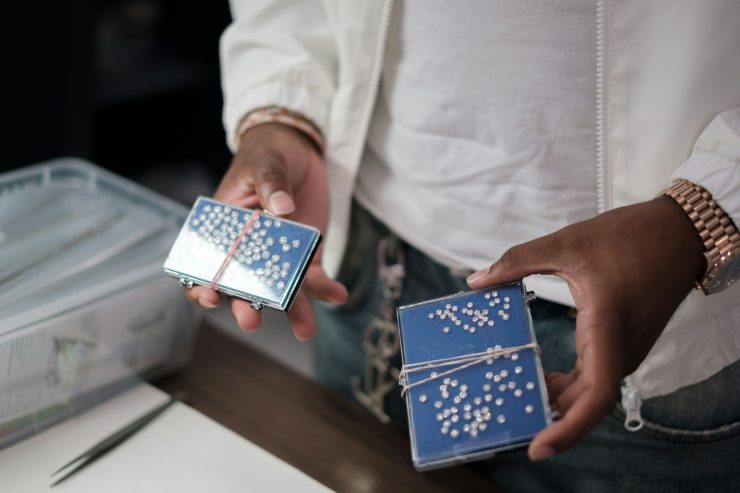Understanding the Unique Nature of Lab Diamonds and Their Value in Transit
Lab-created diamonds are chemically, physically, and optically identical to mined diamonds, but their market dynamics and handling requirements can differ significantly. While these diamonds may be more accessible in terms of cost, they are still high-value commodities that require careful consideration when it comes to shipping and handling. Independent sellers, particularly those without the infrastructure of large-scale retailers, face unique challenges in ensuring that their products are transported securely, efficiently, and cost-effectively. Mishandling during transit can lead to not only financial losses but also reputational damage if customers receive damaged or poorly packaged goods. Therefore, it is critical to understand the fragility and value perception of lab diamonds, which must be treated with the same care as their mined counterparts to preserve both their integrity and market appeal.

Choosing the Right Shipping Carrier and Insurance Coverage
One of the most crucial aspects of shipping lab-grown diamonds as an independent seller is selecting a reliable shipping carrier. Not all carriers are created equal when it comes to handling high-value items. Independent sellers should research and compare the capabilities of carriers such as FedEx, UPS, and DHL, particularly focusing on their high-value item policies, tracking systems, and insurance options. In many cases, carriers offer specialty services tailored for jewelry and gemstones, such as overnight delivery with direct signature requirements and GPS tracking. Insurance is non-negotiable; sellers must ensure that every shipment is fully insured against theft, loss, and damage. Third-party insurers like Jewelers Mutual or ParcelPro often provide more comprehensive coverage than carrier-provided insurance. Ensuring proper documentation of the diamond’s value—such as lab certification, appraisals, and invoices—is essential when filing insurance claims and maintaining professional accountability.
Packaging Standards: Layered Protection and Tamper-Evident Measures
Packaging plays a pivotal role in the successful delivery of lab diamonds, and its design should prioritize both physical protection and theft deterrence. At a minimum, packaging should involve multiple layers, including a cushioned inner box, a sealed plastic gem jar or bag, and an outer corrugated shipping box. The internal packaging should prevent movement to avoid scratches or breakage, even though diamonds are exceptionally hard. To prevent tampering and theft, independent sellers should use tamper-evident seals, security tape, and unmarked outer packaging that does not indicate the valuable nature of the contents. Avoiding brand logos or descriptions like “diamonds” or “jewelry” on the external packaging is a standard best practice. Many sellers also opt to ship using double-boxing, where a small secure package is placed inside a larger one for added anonymity and protection. Moreover, maintaining a packing checklist ensures consistency and helps mitigate human error in the packaging process.
Legal Compliance and Customs Declarations for International Shipments
Shipping lab diamonds internationally involves a different layer of complexity due to customs regulations and legal requirements. Although lab-created diamonds do not require Kimberley Process certification like natural diamonds, they still need to be accurately declared with appropriate documentation. Mislabeling or under-declaring the value can lead to severe penalties, shipment seizures, or reputational harm. Independent sellers should familiarize themselves with the Harmonized System (HS) codes specific to synthetic diamonds and ensure proper classification. Additionally, it’s advisable to clearly state the synthetic nature of the diamonds to prevent confusion or accusations of misrepresentation. Customs paperwork should be thorough, including invoices, certificates of authenticity, and any applicable permits or licenses. Some countries may impose import duties or VAT, and informing buyers in advance about these potential charges is key to managing customer expectations and maintaining transparency. Working with a customs broker or freight forwarder can greatly simplify this process for sellers lacking experience in cross-border trade.
Inventory Tracking, Chain of Custody, and Shipment Documentation
Maintaining meticulous records of every shipment is another fundamental best practice for independent lab diamond sellers. From inventory tracking to proof of delivery, robust documentation safeguards both the seller and the buyer. A clear chain of custody—from the point of packaging to the final delivery—helps in case of disputes, insurance claims, or return handling. Using inventory management software that integrates with shipping platforms can automate much of this process, providing real-time updates and minimizing manual errors. Each package should be associated with a unique tracking number, and sellers should retain digital or printed copies of shipping labels, delivery confirmation receipts, and customer communications. For higher-value items, it may be wise to require a photo ID and signature upon delivery to ensure that the package reaches the intended recipient. Some platforms also allow sellers to capture package opening videos for dispute resolution purposes. Establishing such protocols builds credibility and instills customer confidence in the seller’s professionalism.

Handling Returns and Exchanges with Careful Logistics Planning
Returns and exchanges are an inevitable aspect of selling lab-created diamonds, and handling them properly is essential for maintaining customer trust. A well-defined return policy not only sets expectations but also protects the seller from fraudulent claims. Independent sellers should clearly state the conditions under which returns are accepted—such as time limits, original packaging requirements, and inspection protocols. When accepting a return, it is critical to provide the buyer with a pre-paid, insured shipping label that mirrors the security measures used in the original outbound shipment. Just as outbound shipping must involve tamper-evident packaging and tracking, return shipments should be equally secure to avoid substitution scams or losses. Upon receipt, sellers should conduct a thorough inspection of the returned diamond using lab certification details and high-resolution photographs taken prior to shipment. Having a secure return processing workflow, including video documentation of package opening and item authentication, can help in resolving disputes objectively and efficiently.
Educating Buyers on Safe Receipt and Storage Practices
Shipping best practices do not end when the package reaches the buyer. Many independent sellers overlook the importance of educating their customers on how to safely receive, inspect, and store their lab diamonds. Providing a printed or digital guide with each shipment—covering topics like checking for signs of tampering, inspecting the item for consistency with certification, and securely storing the diamond—can enhance the customer experience and reduce post-sale complications. Encourage buyers to open the package in a secure environment and to record themselves during the process, especially if they are receiving a high-value item. Sellers might also advise on proper storage methods, such as using a lockable jewelry box or safe, and offer guidance on purchasing individual insurance coverage. By extending logistical best practices into the post-delivery phase, sellers not only reduce liability but also demonstrate a commitment to the customer’s long-term satisfaction and security.
Utilizing Technology for Shipping Automation and Error Reduction
The use of digital tools and automation can drastically improve the shipping efficiency of independent lab diamond sellers. Platforms like ShipStation, EasyPost, or Pirate Ship offer integrations with major e-commerce platforms and marketplaces, automating everything from label generation to tracking updates. These platforms can reduce human error by standardizing package dimensions, weight inputs, and shipping service selection. Additionally, some services provide batch processing features that are ideal for sellers managing multiple orders per day. Barcode scanning and automated inventory reconciliation further streamline operations, ensuring accurate fulfillment and minimizing shipping errors. Implementing these technologies not only saves time and effort but also projects a more professional image to the buyer. Moreover, automation supports better data collection, allowing sellers to analyze delivery times, identify bottlenecks, and optimize carrier selection based on cost-performance metrics.
Building Trust Through Transparent Communication and Support
In the high-value world of lab diamond sales, transparency and communication are just as important as physical handling protocols. Buyers expect regular updates and clarity at every stage of the process. Independent sellers should commit to proactive communication by providing order confirmation, dispatch notices, tracking details, and delivery confirmation messages. In cases of unexpected delays, informing the buyer promptly and offering solutions—such as alternative shipping options or partial refunds—can mitigate dissatisfaction. Maintaining multiple customer service channels, such as email, messaging apps, and even phone support, enables quicker resolution of concerns. Post-delivery follow-ups to confirm customer satisfaction also help reinforce the relationship and gather useful feedback. Trust-building is especially critical for independent sellers who do not benefit from the brand reputation of major jewelry retailers; clear, honest, and accessible communication becomes a key differentiator in such a competitive marketplace.
Developing Long-Term Logistics Strategies and Scalability Planning
Finally, as an independent seller grows, scalability must be factored into the logistics strategy. What works for shipping a few lab diamonds per month may not be sustainable when volume increases. Sellers should periodically assess their shipping practices, packaging costs, carrier reliability, and fulfillment times. Establishing partnerships with third-party logistics providers (3PLs) or fulfillment centers that specialize in jewelry and high-value items can offload operational burdens and enhance delivery capabilities. Additionally, bulk shipping discounts, negotiated insurance rates, and advanced inventory systems become more accessible with higher volumes. Long-term planning should also include risk management, such as setting aside reserves for lost or damaged shipments, and investing in continuous training for staff on security protocols. Independent sellers who incorporate a growth mindset into their logistics framework will be better prepared to meet rising demand while maintaining the high standards their clientele expects.